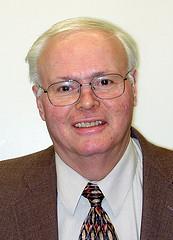
Professor Robert R. Alfano
Techniques That Improve Seeing Through Water Could Apply to Trident Submarine Navigation
Dr. Robert R. Alfano, CUNY Distinguished Professor of Science and Engineering at The City College of New York (CCNY), will address a gathering of U.S. Department of Defense (U.S. Navy) researchers and officials meeting Wednesday, May 26, at Lockheed-Martin offices in Garden City, NY. He will discuss the potential application of his work in ultrafast propagation of light through dielectric media and seeing through scattering and absorption walls to improve underwater navigation systems for the U.S. Navy Trident–class submarine program.
“The Trident submarine program is one of the keystones of America’s strategic defense,” Professor Alfano noted. “It is intensely gratifying, from both a professional and patriotic standpoint, to learn that your research has the potential to make a significant contribution to our nation’s security.”
In his presentation, Professor Alfano will describe some of the basic properties, key equations and lengths governing light propagation through water, fog and clouds. He will also present his research on ways to have light travel longer distances in water and on improved detection of light by gating out photons that blur useful signals. In addition, he will discuss new and novel ways to see further under water by using specially formed light pulses.
When a light pulse enters a dielectric medium, i.e. a poor conductor, such as water, the photons are absorbed quickly, he explained. However, precursors, which are wave patterns that are forerunners to the main signal, can penetrate further because their energy attenuates algebraically with travel distance while the main signal’s energy attenuates exponentially.
These have been called Brillouin (BP) and Sommerfield (SP) precursor pulses, which were introduced in 1914 by physicists Leon Brillouin and Arnold Sommerfield. Recently, the search for precursor pulses in the optical regime has become an active area of research. Some investigators believe they have generated BP in water.
Professor Alfano and Dr. Xiaohui Ni, a research associate in the Institute for Ultrafast Spectroscopy and Lasers(IUSL), along with Dr. Joseph Birman, Distinguished Professor of Physics at CCNY, have proposed the existence of BP in semiconductors in the terahertz regime (1012 Hz). Professor Alfano and Dr. Ni plan to use their knowledge in this area to produce special pulses that will travel further to improve imaging through scattering and absorption walls.
“A short pulse with the right wavelength can travel longer than expected,” Professor Alfano said. “The supercontinuum, which is considered the ultimate white light source for generating short laser pulses since it contains lots of wavelengths in a short burst, is crucial to advances in enhanced light propagation and imaging in water and other scattering media.”
In 1970, Professor Alfano reported discovery of the supercontinuum, a light having both high spatial coherence and broad spectral bandwidth. For this discovery and other work in photonics, he received the Optical Society of America’s Charles Towns Award in 2008.
In addition to his work of interest to the Trident submarine program, Professor Alfano and colleagues at IUSL, which is based at CCNY, have conducted numerous studies, including several investigations funded by the U.S. Army Medical Command, in the application of photonics imaging to medical diagnosis of breast cancer and prostate cancer using photonic gating.
He is currently working with PhD student Yang Pu and IUSL senior research associate Dr. Wabao Wang on developing a new imaging unit that will not only detect the tumor but also diagnose it optically using near-infrared light. On April 27, they were awarded U.S. Patent 7,706,862, “Detecting Human Cancer Through Spectral Optical Imaging Using Key Water Absorption Wavelengths.”
MEDIA CONTACT
Ellis Simon
p: 212.650.6460
e:
esimon@ccny.cuny.edu